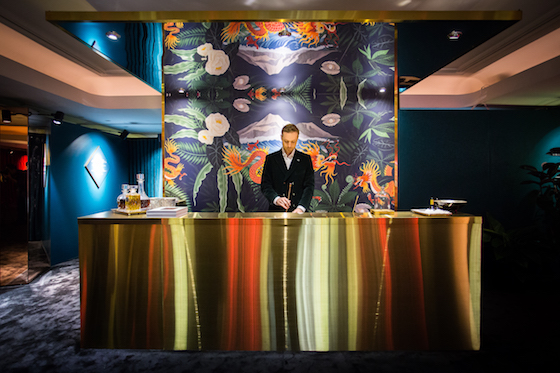GOSTELOW REPORT—On Friday, October 19, InterContinental Hotels Group, revealed third-quarter figures that showed the strongest Q3 pace for 10 years, and US$500 million will be returned to shareholders as a special dividend with share consolidation. As it happened, top management, led by CEO Keith Barr, were already on a professional high following the previous day’s one-off theatrical performance to introduce the new-look Regent brand, in Hong Kong.
Yes, as already reported, IHG unveiled its Regent concept on that day, but emotion-free press releases did not even hint that the show was a professional event worthy of an Oscar. The production was intentionally unveiled at InterContinental Hong Kong, which will close sometime early 2020 for a complete new look – after which it will revert to its former name, The Regent Hong Kong (the designer has not yet been chosen, but it is possible that about 10 of the current 514 rooms and suites may be lost).
The 800 team members are, however, already beginning to “think Regent.” Head concierge Louis Baleros, one of about 150 who was here in the old Regent days – pre-2001 – says his father, a third-generation hotelier, was head concierge when the original Regent first opened, in 1980.
The revelation of new-look Regent DNA was led by Barr, attended by CEO Europe, Middle East, Asia & Africa Kenneth Macpherson, and CEO greater China, Jolyon Bulley, and at least a couple of dozen relevant IHG participants.
One of its Regent brand’s differentiators, indeed, is that its taste-makers are not, as is often the case in the hotel industry, unknown outside the office. The new-look Regent DNA, while respecting its heritage, is being brought back to life under the supervision of Justin Channe, an IHG veteran who is managing director of Regent Hotels & Resorts, based in Shanghai. “I was asked if I would take this role this May, and I immediately started work, supported by IHG’s two VPs Global Luxury Brands, Tom Rowntree and Ginger Taggart,” he recalled.
Both brand leaders were actively involved in last week’s immersive “journey,” to which existing and prospective owners were invited. Channe and Rowntree explained how customer focus groups had included one at the U.K.’s Houses of Parliament in London. What do high-net-worth consumers of all ages, including high-achieving millennials, actually want in a luxury hotel?
They do not want nickel-and-diming, or to be structured – they prefer to eat and drink what they want, when they want. They do want more seamless communication with their own support staff back home. Above all they want space, and calm.
As invitees progressed from one jewel-like room to another, Taggart said that the resulting DNA of new-look Regent comes with a promise to be “majestically intimate,” on guests’ terms, and at all time to inspire discoveries. That is not unique in the industry but what does seem to be new is that every hotel will have its own one-off ambience that is 50% serene, with the signature color, Regent Green, based on celadon ceramics – another 40% of the ambience will be creative harmony, with a final 10% of decadence, perhaps a kaleidoscope of color.
As well as private nooks in public areas and surrounding grounds, every bedroom and/or its oasis-type bathroom will have cocoon areas, perhaps a double day-bed by a window overlooking a stunning view, to chill out.
Instead of looking at other luxury hotel brands, the team studied such pinnacle marques as Bentley, whose design director, Stefan Sielaff, applauds the Regent concept for being very human and personal. Every hotel will have a Taste Gallery, which will combine cuisine and culture. Memorable foods and beverages may even include a regular roster of pop-up chefs. There will be hotel-bespoke aromas specially created by Ireland-born parfumier John Molloy of Memo Paris. There are also such luxury-generic elements as sensational music, wellness working with best local specialists on, say, mindfulness and therapy. The seamless journey goal will include pre- and post-stays.
There are today Regent properties in Beijing and Chongqing, China; Berlin; Porto Montenegró; Singapore, which will be managed by Capella Hotels and Resorts as of January 1, 2019; and Taipei, which is owned by Pan. The pipeline is Phú Quoc, Vietnam and Jakarta – yes, initially the new-look Regent will be Asia-dominant. All Regent hotels will be managed, with no franchises, and, depending on the location, IHG expects ADR to be about 35% above that of a comparable InterContinental, a brand which will not be re-positioned by having an apex, Regent, join the growing IHG family.
There might be three or four re-brandings, from existing InterContinentals to Regent. “It all depends on properties’ owners. It already looks as if owners like what we are doing. We signed our first additional Regent this morning, a 300-room property in Kuala Lumpur, Malaysia, and in all we plan to work up to about 40 properties,” said Jolyon Bulley at the event on October 18.
Keith Barr agreed he is thrilled at the reaction of existing and prospective owners, citing figures that show luxury travel is worth US$60 billion a year today and on track to increase to US$95 billion by 2025.

